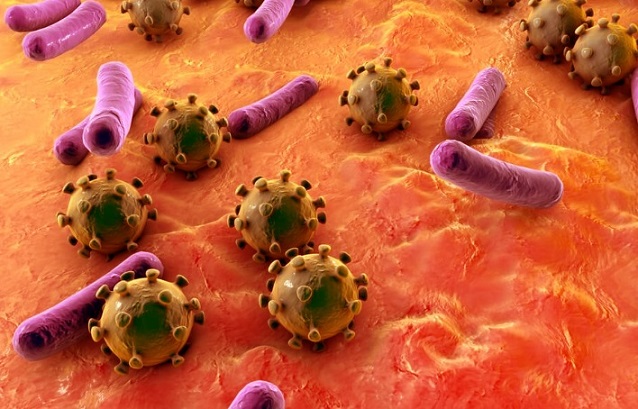Nikhil Prasad Fact checked by:Thailand Medical News Team Feb 02, 2025 2 months, 1 week, 5 days, 5 hours, 10 minutes ago
Medical News: Influenza A H5N1, commonly known as bird flu, remains a global health concern due to its ability to mutate rapidly and resist antiviral treatments. Researchers from King Abdulaziz University in Saudi Arabia and Saveetha University in India have been investigating an innovative approach to tackling this virus. By studying compounds derived from marine bacteria, scientists have identified promising candidates that may inhibit the influenza polymerase PB2 cap-binding domain, a critical component of the virus’s replication process.
 Scientists Explore Marine Bacteria for Potential Influenza A H5N1 Treatment
Scientists Explore Marine Bacteria for Potential Influenza A H5N1 Treatment
This
Medical News report highlights the findings of the study, which employed advanced computational methods to screen and evaluate potential inhibitors. The discovery of these marine bacterial compounds marks a significant step in the ongoing battle against influenza, as they offer new possibilities for antiviral drug development.
Marine Bacteria as a Source of Influenza-Fighting Compounds
Marine bacteria have long been recognized for their potential in pharmaceutical applications due to their diverse and unique biochemical properties. The researchers conducted a virtual screening of 1501 compounds from a marine bacterial database to identify those with the highest binding affinity for the PB2 cap-binding domain of the influenza virus. This domain plays a crucial role in viral replication, making it an attractive target for new antiviral drugs.
Among the compounds screened, four stood out as the most promising: CMNPD25830, CMNPD18675, CMNPD18676, and CMNPD27216. These compounds exhibited strong molecular interactions with the PB2 cap-binding domain, suggesting their potential as effective inhibitors of the virus’s replication process.
Computational Analysis Validates Potential of New Inhibitors
To further evaluate these compounds, the researchers conducted molecular docking studies and molecular dynamics simulations. These advanced computational techniques help predict how well a compound binds to a target protein and assess its stability over time.
Molecular docking simulations revealed that CMNPD25830 and CMNPD27216 had the highest binding affinities among the four compounds, surpassing the control molecule used in the study. Additionally, molecular dynamics simulations confirmed the stability of these interactions, showing that the compounds remained tightly bound to the PB2 cap-binding domain over an extended period.
Another crucial aspect of the study involved free energy calculations, which help determine the strength and stability of molecular interactions. CMNPD27216 exhibited the most favorable binding energy, indicating a highly stable and effective interaction with the influenza virus target. This suggests that the compound could serve as a potent antiviral agent if further validated through experimental studies.
Key Findings from Molecular Dynamics Simulations
The study’s finding
s provide a detailed understanding of how these marine bacterial compounds interact with the influenza virus at a molecular level:
-Stable Binding: CMNPD25830 and CMNPD27216 maintained strong and stable interactions with the PB2 cap-binding domain throughout the simulation period.
-Superior Free Binding Energy: CMNPD27216 demonstrated the lowest free binding energy (-57.14 kcal/mol), indicating strong molecular interactions, while CMNPD25830 also showed promising stability.
-Hydrogen Bonding: The compounds formed stable hydrogen bonds with key amino acids in the PB2 cap-binding domain, further reinforcing their potential effectiveness as inhibitors.
-Structural Stability: Root mean square deviation (RMSD) and radius of gyration (RG) analyses confirmed that these compounds remained stable and tightly bound within the target protein’s active site.
Implications for Future Influenza Treatments
The identification of CMNPD25830 and CMNPD27216 as strong PB2 cap-binding domain inhibitors is a promising development in influenza drug research. While existing antiviral drugs like oseltamivir (Tamiflu) target different viral components, these newly identified compounds focus on disrupting a critical step in the virus’s replication process. This novel approach may help overcome resistance issues that have emerged with current influenza treatments.
The researchers emphasize that while these findings are highly promising, further validation through laboratory experiments and clinical studies is necessary before these compounds can be developed into viable antiviral drugs. In vitro and in vivo studies will be needed to confirm their effectiveness and safety in biological systems.
Conclusion
The search for new antiviral treatments has led scientists to explore the vast and largely untapped potential of marine bacteria. The study’s findings suggest that CMNPD25830 and CMNPD27216 could serve as effective inhibitors of the influenza A H5N1 PB2 cap-binding domain, potentially paving the way for new and improved influenza treatments. This research not only highlights the importance of computational drug discovery techniques but also underscores the need for continued exploration of natural compounds in the fight against viral infections.
As the world continues to face challenges from emerging and re-emerging influenza strains, the discovery of new antiviral agents remains a critical priority. The potential of marine bacteria-derived compounds offers hope for more effective treatments in the future.
The study findings were published in the peer-reviewed journal: PLOS ONE.
https://journals.plos.org/plosone/article?id=10.1371/journal.pone.0310836
For the latest H5N1 News, keep on logging to Thailand
Medical News.
Read Also:
https://www.thailandmedical.news/news/traditional-chinese-medicine-breakthrough-qi-pi-pill-shows-promise-against-influenza
https://www.thailandmedical.news/news/alkylamides-from-echinacea-shows-promising-effects-against-respiratory-viruses
https://www.thailandmedical.news/news/usda-and-aphis-warns-of-more-domestic-cats-getting-infected-with-h5n1-in-the-united-states
https://www.thailandmedical.news/articles/h5n1-avian-flu
https://www.thailandmedical.news/articles/influenza-or-flu
https://www.thailandmedical.news/articles/hmpv-human-metapneumovirus
